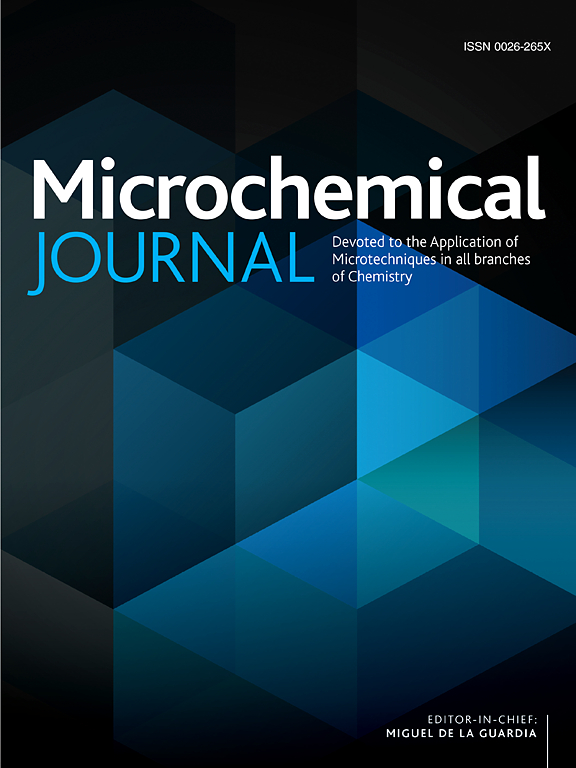用于同时自动测定食品中极性和非极性染料的准疏水性深共晶溶剂
IF 4.9
2区 化学
Q1 CHEMISTRY, ANALYTICAL
引用次数: 0
摘要
在这项工作中,我们首次使用了准疏水性深共晶溶剂来同时高效萃取食品中的极性染料(日落黄 FCF (E 110)、偶氮染料 (E122)、胭脂红 4R (E124))和非极性染料(苏丹一号、苏丹二号、苏丹三号)。这些溶剂由极性和非极性成分制成,因此可以提取各种性质的分析物。为了使这项技术自动化,使用了流动分析方法,从而提高了测定食品样品中分析物的速度和可靠性。为了详细研究萃取机制,使用了各种过程建模方法。所提出的基于 DES 的方法解决了传统萃取方法的局限性,为食品分析提供了一种更稳健、更高效的解决方案。该方法的验证结果表明,其精确度、准确度和萃取效率都很高,是食品行业中符合法规要求和保障消费者安全的一种很有前途的工具。该方法具有以下分析特性:检出限为 0.03-0.13 毫克/升,定量限为 0.09-0.44 毫克/升,萃取回收率超过 85%,线性范围为 1-100 毫克/升,相对标准偏差为 2%-10%。实验结果得到了COSMO-SAC(Conductor Like Screening Model-Segment Activity Coefficient)和水介质中DES-染料体系的还原密度梯度非共价相互作用的证实。本文章由计算机程序翻译,如有差异,请以英文原文为准。
Quasi-hydrophobic deep eutectic solvents for simultaneous automated determination of polar and non-polar dyes in food products
In this work, quasi-hydrophobic deep eutectic solvents were used for the first time for the efficient extraction of both polar (Sunset Yellow FCF (E 110), Azorubine (E122), Ponceau 4R (E124)) and non-polar (Sudan I, Sudan II, Sudan III) dyes from food products at the same time. These solvents were made from polar and nonpolar components, which made it possible to extract analytes of various natures. To automate the technique, a flow analysis method was used, which increases the speed and reliability of determining analytes in food samples. For a detailed study of extraction mechanisms, various process modeling methods were used. The proposed DES-based method addresses the limitations of traditional extraction methods, offering a more robust and efficient solution for food analysis. Validation of the method has demonstrated high precision, accuracy and extraction efficiency, making it a promising tool for regulatory compliance and consumer safety in the food industry. The following analytical characteristics were achieved: the limits of detection were 0.03–0.13 mg L, limits of quantification were 0.09–0.44 mg L, an extraction recovery exceeding 85 %, a linear range was from 1 to 100 mg L, and a relative standard deviation ranging from 2 % to 10 %. The experiments were confirmed by both Conductor Like Screening Model-Segment Activity Coefficient (COSMO-SAC) and the Non-Covalent Interaction using the Reduced Density Gradient of the DES-dye system in aqueous media.
求助全文
通过发布文献求助,成功后即可免费获取论文全文。
去求助
来源期刊

Microchemical Journal
化学-分析化学
CiteScore
8.70
自引率
8.30%
发文量
1131
审稿时长
1.9 months
期刊介绍:
The Microchemical Journal is a peer reviewed journal devoted to all aspects and phases of analytical chemistry and chemical analysis. The Microchemical Journal publishes articles which are at the forefront of modern analytical chemistry and cover innovations in the techniques to the finest possible limits. This includes fundamental aspects, instrumentation, new developments, innovative and novel methods and applications including environmental and clinical field.
Traditional classical analytical methods such as spectrophotometry and titrimetry as well as established instrumentation methods such as flame and graphite furnace atomic absorption spectrometry, gas chromatography, and modified glassy or carbon electrode electrochemical methods will be considered, provided they show significant improvements and novelty compared to the established methods.
 求助内容:
求助内容: 应助结果提醒方式:
应助结果提醒方式:


